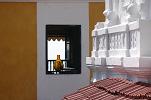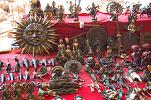|
|
Goa History
Ancient And Pre-Colonial Period
| Think of Goa history, and Portuguese Goa springs instantly to mind. The state is indeed heavily influenced by this colonial period of time, and its history lives in Goa's many churches, religious practices, food and architecture. The history of Goa, of course, spans for several millennia before the first Portuguese ships arrived. This page offers a concise overview of important periods in Goa's history before the Portuguese colonial rule and subsequent route to independence. |
Ancient Goa History| Around 12,000 to 10,000 BC, geological events in the region of south west India are thought to have resulted in the elevation of the coastal area that is now Goa. Burnt shells and fossils in Goa's soil seem to confirm this. Strangely, Hindu mythology also ties in with this event. According to myth, Parasurama (an incarnation of Vishnu) was rewarded for military success by being given land for his Brahmin caste to live in peacefully. He fired seven arrows from the mountains of south India out over the sea. Wherever they fell, the sea receded and revealed his lands. Migrants from central India are believed to have populated the land that is now Goa, though discoveries in the hills of Goa's east show that the area was inhabited for centuries before the agricultural, migrant settlers. Cave art in the area dates from around 100,000BC to 10,000BC and points to an ancient hunter-gatherer population in the region. From around 600 BC it is believed that signifiant numbers of settlers came to Goa from central India, and the area is referred to in the Mahabharatha (ancient Hindu script) as Gopakapuri, or 'Cowherd Country'. Ancient Greeks traded with the area and referred to it as 'Melinda'. For a relatively brief period, under the Mauryan empire a Greek Buddhist missionary was sent to the region by the emperor Ashok. Buddhist settlers preached non-violence, and improved literacy and farming methods, but after Ashok's death in 232BC the empire crumbled, and Brahminical Hinduism returned as the main religion. |
Hindu Golden Age Of Goa History
A series of powerful Hindu dynasties controlled Goa from afar, but by 420 AD a dynasty native to Goa, the Kadambas was able to achieve dominance over the region, using marital ties to secure alliances with their neighbours. The Kadambas secured the capital, Chandrapura, from the Rashtrakutas (who had recently been defeated by an ally) in 973 AD. Moving northwest they settled on the banks of Goa's Zuari river where they were able to profit from the trade of horses and spice between India and Arabia that passed through the Malabar coastal region. Beautiful stone temples were erected during this opulent time of Goa history, and Muslim traders that were encouraged to settle the region added to the rich architecture with mosques and villas. By 1200 AD however, the region was at risk from Muslim raiders sweeping through India as the Kadambas old protective alliances had grown weak.
Muslim Invasions in Goa History
| Muslim raids took place in Goa throughout the tenth to the fourteenth century AD. The first of these was at the command of the warlord Mahmud of Ghanzi from Delhi. Most of the raids were directed at Kadamba temples where much wealth was held. The attacks grew more violent as time passed, and eventually the old capital of Chandrapura lay in ruins. Despite these attacks, Muslim merchants and their hosts managed to stay on friendly terms. Sadly when the Muslim Bahmanis arrived in 1350 and began a bloody persecution of Hindus in the area, these ties were destroyed. In 1378, Hindu kings of the Vijayanagar empire (whose capital was Hampi, now in Karnataka) retaliated by massacring the Bahmani settlers in the Goa capital, but the city fell again into Bahmani hands in 1470, when a massive Bahmani force attacked from both sides, with an army from the east and warships off the coast. The capital had declined by this time, and the Bahmanis moved north to the Mandovi River and erected a prosperous capital known as Ela (10kms from the present day capital of Panaji). It was to become the wealthiest city on the south west coast of India. |
It is not suprising, considering the wealth of the region, that at the end of the 15th Century, India's west coast had captured the interest of the expansionist, sea faring country of Portugal. Despite a history jaded by atrocity and violence, the colonial period of Portuguese Goa was essential for shaping Goa as it is today.
Read about the Portuguese history of Goa and Goa's route to independence.
Read more about Goa, India.
^TOP^
Click here to leave Goa History and return to Travel India Goa Guide Home
Goa Festivals -
Goa India Guide -
Goan Food -
Weather In Goa -
Goa Map -
Goa Pictures -
Kerala

|
|
|







